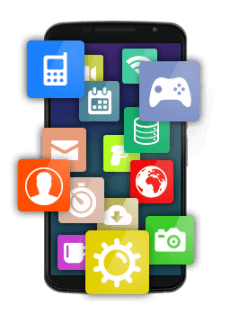
How to Monetize an App for Revenue and Value in 3 Easy Steps
Monetization of an app can be broken down into three steps: paid downloads, in-app purchasing, and in-app advertising.
1. The Low Down on In-App Advertising
A frequent question people have about free apps is, “How do they earn money if it’s free?” It is likely that in-app advertising provides that revenue.
In-app advertising is a way for the third-party apps to advertise to your users. Think of it like borrowed real estate on a smartphone, and you will see the true value of the screen being a piece of property. Third-party apps will pay a good chunk of change to appear on your users screens. The in-app advertisements are shown in three ways: banners, pop-ups, and videos.
Banner: banners with a small-screen width that are presented at the bottom of the screen – essentially the opposite of an alert.
Pop-Up: pop-ups are triggered after an event in full-screen size (when an app is opened when there has been a loss or advance to the next step in a game, etc.).
Video: videos are full-screen and show a 15-30 second video that’s triggered after an event.
Much like the web, there are different types of pricing, benefits and drawbacks for each type of in-app advertisement.
The good thing about paid advertising is that it happens to be the only form of monetization where the user isn’t required to purchase something. The advertisers are responsible for the cost.
An obvious drawback about having paid ads in your app is that the user can become annoyed and feel intruded upon. Take into consideration how often the ads are presented and the intensity of them because the last thing you want is to lose your users.
2. Let’s Talk About Paid Apps
Years ago, you could be offered three different types of computer programs to make your daily life easier, and it would cost you upwards of about $100-$300 dollars for the bundle. Nowadays, the apps on our phones and tablets are just as useful, although they are a fraction of the cost, yet users are reluctant to commit to a $0.99 app purchase before testing the waters first.
There is still an opportunity for earning a decent revenue through paid downloads, though. All you have to do is prove your app’s value to the user.
Paid downloads do have a few drawbacks. Users tend to have a higher expectation for paid apps, and that means that you have to deliver on that expectation. If you don’t, you can expect to have some unpleasant reviews. Unpleasant reviews can tarnish your app’s reputation and influence users looking to purchase your app.
Users usually have a resistant nature to any further monetization efforts. Let’s say a user just spent $2.99 for your premium app, they will expect an ad-free experience and access to all features involved in your app. And because of this, the ceiling of revenue is considerably fixed.
The one thing that paid downloads don’t offer in scale, but they compensate with reliability. You can’t predict how many users will opt for the paid version, but you can predict how much revenue each user will generate. For example, if you charged $2.99 for your premium app and you were to have 10,000 downloads of said premium app, you will have generated $29,000 in revenue!
3. The Story on In-App Purchases
Typically, when you think in-app purchases, you think of eCommerce applications. Realistically, they are everywhere and not just limited to one area. Some games will limit their users to a set number of levels before they have to purchase a premium version or make you share and lock in a set number of people to play the app. Other types of apps offer password protection and incentives when you purchase the premium versions. There are some apps that will penalize you with a five-day sleep time that will cause you to lose your history unless you purchase a premium version that allows you to keep all of your history.
The underlying factor here is to give your users exactly what they want without giving it all to them at one time. You need to let them see the value that comes with purchasing the full version of the app. Achieving this will most likely take some time on your end, tweaking and practicing after the launch. You can gain insight in your apps analytics and measure which structure works best for your users.
If you would like to speak to one of our app development and mobile app marketing consultants, please contact Net-Craft.com today for a complimentary consultation.